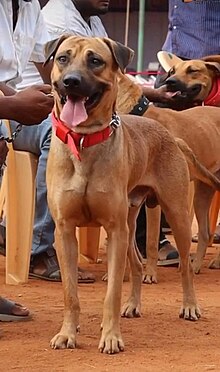| Kombai | |||||||||||||||||||||||||||||||||
|---|---|---|---|---|---|---|---|---|---|---|---|---|---|---|---|---|---|---|---|---|---|---|---|---|---|---|---|---|---|---|---|---|---|
 Kombai male Kombai male | |||||||||||||||||||||||||||||||||
| Origin | Tamil Nadu, India | ||||||||||||||||||||||||||||||||
| |||||||||||||||||||||||||||||||||
| |||||||||||||||||||||||||||||||||
| Dog (domestic dog) | |||||||||||||||||||||||||||||||||
The Kombai or Polygar dog is a breed of working dog native to Tamil Nadu in Southern India. Traditionally kept for guarding and protection, they have a reputation for making excellent guard dogs. They were also occasionally used for hunting big game.
Description
The Kombai is described as a broad, short, muscular, powerful and athletic dog that stands around 58 centimetres (23 in). They have a short, smooth coat that is usually light brown to dark red in colour, and a black muzzle. They have dark eyes, the mid-length ears with bent tips, and a fine muzzle. The breed has a broad, slightly haired tail that is carried over their back resembling a sickle.

The Kombai is described as highly intelligent and extremely loyal to, and affectionate with, people they are familiar with, being particularly sweet-natured and tolerant of children with whom they allow particularly rough play, but when aroused by strangers or unfamiliar dogs they can be ferocious, making them excellent guard dogs.

History

The breed originated in the Theni district and is named after the town of Kombai. It subsequently spread throughout Southern India. The Kombai was traditionally kept by zamindars and others for coursing a variety of game. When hunting it is particularly robust and athletic, easily clearing hedges and other obstacles. They are also called polygar dogs.

The Kannada Vokkaliga zamindars of Kombai presented Tipu Sultan and Hyder Ali with these dogs for their army. The ferocious dogs were trained to rip the hamstrings of enemy horses. Tipu sent the town an idol of Ranganathaswamy in gratitude. It is said that the Kombai polygars valued the dog so highly that in olden days they were ready to exchange a horse for one.
There are conflicting reports about the status of the breed; some reports from the 1960s stated the dog was popular and numbers were increasing, whilst others from the same period described them as practically extinct. A Tamil Nadu state-run dog-breeding facility did take up the cause of breeding the Kombai, along with a number of other local breeds. However, it was reported they suspended their Kombai breeding program when owners who had purchased dogs returned them, finding their character ill-suited to keeping as pets.
See also
References
- Y. B.Rajeshwari (9 June 2009). Handbook on Care and Management of Laboratory and Pet Animals. New India Publishing. p. 13. ISBN 9788189422981.
{{cite book}}: CS1 maint: date and year (link) - ^ Morris, Desmond (2001). Dogs: the ultimate dictionary of over 1,000 dog breeds. North Pomfret, VT: Trafalgar Square Publishing. p. 326. ISBN 1-57076-219-8.
- ^ Soman, W.V. (1962). The Indian Dog. Mumbai: Popular Prakashan. p. 91.
- ^ Herman Jensen (2002). Madura Gazetteer. Madurai, India: Cosmo Publications. p. 319. ISBN 9788170209690.
Kombai:Four miles...The well known Kombai ( or ' poligar ' ) dogs came originally from here and can still with some difficulty be obtained.
- ^ Kolappan, B. (8 September 2014). "Bid to popularise ferocious Kombai". The Hindu. Chennai. Retrieved 3 December 2020.
- S. Theodore Baskaran (1999). The Dance of the Sarus: Essays of a Wandering Naturalist. New Delhi ; New York: Oxford University Press. ISBN 0195649664. OCLC 43905202.
The Kombai, from a small town of that name in Madurai district, is also known as the Poligar dog.
- C.S. Ramakrishna Aiyar, ed. (1921). "The Hindu Law Journal". 2. Coimbatore: C.S. Ramakrishna Aiyar, : 5. OCLC 7783197.
The Kombai Parivarams , who are the servants of the Kappiliyan Zamindars of Kombai and Tevaram in the Periyakulam taluk...
{{cite journal}}: Cite journal requires|journal=(help) - Herman Jensen (2002). Madura Gazetteer. p. 320. ISBN 9788170209690.
Unlike the majority of their confreres in this district, who are Telugu Tottiyans by caste, its poligars were Canarese Kappiliyans, and there is a vague tradition that they came from the Mysore country via Conjeeveram.
- ^ Umachandran, Shalini (30 Sep 2015). "Tipu a misunderstood patriot: Historians". The Times of India. India. Archived from the original on 8 Nov 2020. Retrieved 25 March 2021.
When Hyder Ali and Tipu Sultan were invading the south, the zamindars of Kombai, who are Kannada-speaking Vokkaligas, presented Tipu with Combai dogs for their army
- Outlook, Volume 49, Issues 8-16. India: Hathway Investments Pvt Limited. 2009. p. 58.
The regal white Rajapalayam , the Indian Great Dane , and Kombai , the Indian bear hound , who bit at the hamstrings of horses of the British cavalry in the Poligar wars.
- Herman Jensen (2002). Madura Gazetteer. Madurai, India: Cosmo Publications. p. 319. ISBN 9788170209690.
No one takes much interest in breeding them now, but old papers say that in days gone by the poligars of this part of the country valued a good dog so highly that they would even exchange a horse for one.
| Dogs originating in India and Sri Lanka | ||
|---|---|---|
| India | ||
| Sri Lanka | ||